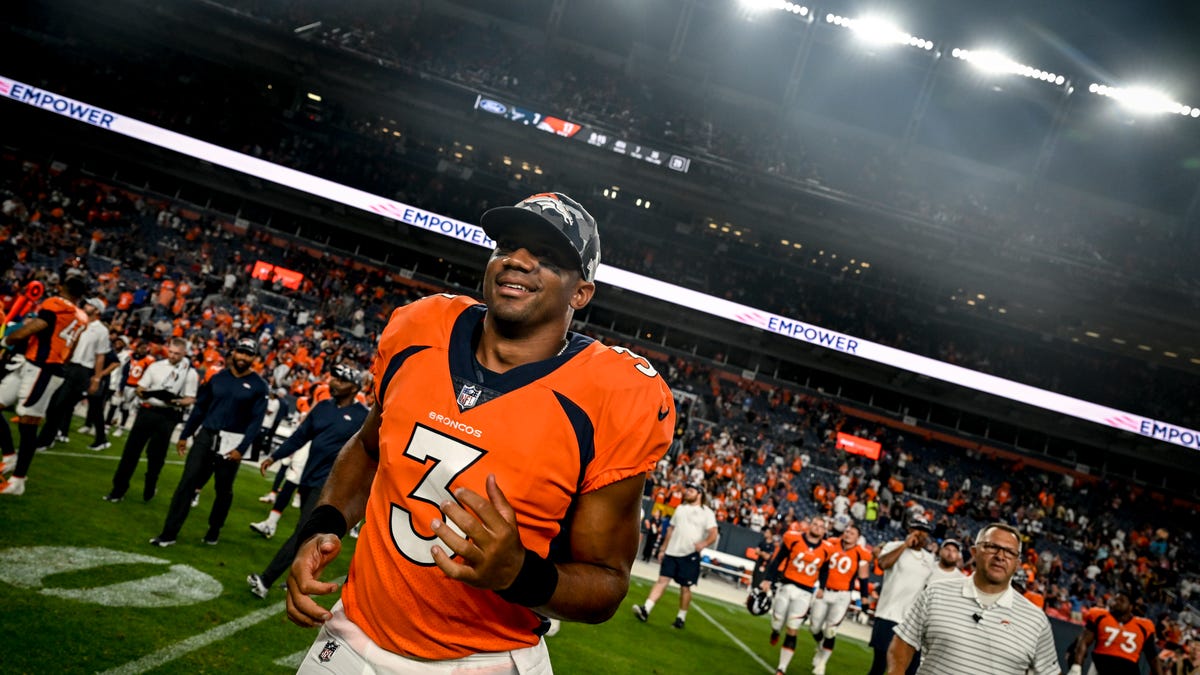Are Russell Wilson’s best days behind him?

The odds have always been stacked higher than Russell Wilson’s 5-foot-11 frame. A decade into his NFL career, he’s vanquished the skeptics who thought he was too short to excel under center behind towering offensive linemen. Wilson’s high release which prevents defensive linemen from batting down his attempts from the pocket and his parking lot donut rollouts have enabled the third-round pick from the 2012 Draft to outlast his peers. RG3 and Andrew Luck have moved on from football while Wilson won a Super Bowl. He may be a walking mea culpa whose risk-it-or-no-biscuit passing cost his Seattle Seahawks a second Super Bowl, but he’s destined for Canton.
As he closes in on the second half of his career, voices from his old past have speculated that he’s a deteriorating asset rather than the fulcrum of a Super Bowl contender. Last season was easily the worst of his career in a variety of ways. His 60.6 QBR was the second-worst of his entire career and Seattle’s seven wins were their fewest since the year before Wilson was drafted. However, he also missed multiple games to repair an injury on his throwing hand while competing in the NFL’s toughest division. After negotiating a trade to Denver, Wilson still plays in the NFL’s toughest division, but if a 25-to-6 touchdown-to-interception ratio in a down year is considered washed, then Wilson is a no-brainer franchise cornerstone for at least the next five seasons.
In recent years, Wilson has been perceived as a Jekyll and Hyde quarterback in the second half of the season, who trends downwards after October. But is that reality?
Let’s review the last five seasons beginning in 2017 when Wilson took command of the offense. This was the birth of Apex Russ, who broke Eli Manning’s record for fourth-quarter touchdowns in a single season with 19 and led the entire league with 34 total scoring throws. Yet, in the second half of the season, his role was diminished by Pete Carroll. Seattle lost three of its final four games and missed the postseason. In the first half of their must-win Week 17 matchup against Arizona, Wilson completed just 4-of-8 passes for 36 yards before he was given the green light in the second half, where he passed for 185 yards. They lost in the final seconds when Blair Walsh shanked the game-winning kick. In the first half of the season, Wilson maintained a 17:6 TD-INT ratio, throwing an average of 288 yards per game. On the backend, Wilson’s average had dipped to 209 yards per game, as he flung 17 touchdowns and six picks.
In 2018, Wilson again came out of the gates scorching by tallying 18 touchdowns, and five interceptions. The second half saw Wilson improve upon his first half with a 17:2 ratio, despite a slight dip in average passing yardage from 223 in the first half to 207 in the final eight games. After going 5-3 in the first half of the season, Seattle went 6-2.
G/O Media may get a commission

Simply compatible
All the essentials to help you monitor your fitness, keep connected, track your health, and stay safe. Now up to 20 percent faster, with features like Crash Detection and enhanced workout metrics, it’s a better value than ever.
In 2019, Wilson led PFF’s WAR metric with a 4.08 rating that outpaced Patrick Mahomes (2.96) and Dak Prescott (2.40). However, in the second half of the season, he actually improved.
First eight games: 14 TDs, 4 INTs, 265 yards per game (6-2 record)
Final eight games: 17 TDs, 1 INT, 247 yards per game (5-3)
In 2020, Seattle’s offense was averaging 34.2 points per game through the first seven weeks and Wilson was flinging the pigskin like an MVP front-runner, having thrown 26 touchdowns to six picks. In the final nine games of the season, the offensive scoring average dipped by 10 points as Wilson lodged 14 touchdowns, seven interceptions and gained an average of 74 fewer yards per game due to Carroll taking the ball out of Russ’ hands with the condescending tone of the bartender cutting off a drunk regular. In the second half of that season, defenses shifted to more two-high safety coverages. As Wilson’s completion percentage ticked up, it limited the explosiveness that Seattle’s offense fed on for sustenance.
Earlier this week, ESPN’s Brady Henderson detailed how the relationship between Pete Carroll and Wilson crumbled. An anecdote from Seattle’s loss to Los Angeles in Week 10 of the 2020 season explained the frustrations boiling over Wilson’s second-half spiral.
Wilson’s lead on winning his first MVP in 2020 quickly faded when the prolific stretch gave way to the worst turnover funk of his career. Wilson committed 10 over the next four games, and with their defense also faltering, the Seahawks went 1-3. One of Wilson’s seven interceptions in that stretch came in a loss at the Los Angeles Rams in Week 10. Trailing by a touchdown, he scrambled to his right and had a massive swath of empty turf in front of him. He bypassed the rushing yards, uncorking a deep heave back across the field that was picked off in the end zone. “What are we doing here?” one source in the Seahawks’ front office remembers thinking at the time. “Are we trying to win games or are we trying to win MVP?”
Russ’ cumulative first-half record since 2017, excluding 2021’s destruction of Pompeii season, was9.9 23-9. His second-half record? 21-11.
Like much of the narrative around Russ, the narrative that he unravels in the second half of the season is a myth built on situational recency bias. In reality, Wilson owns the third-best touchdown-to-interception ratio in league history.
According to various members of Seattle’s front office, a decline was just over the horizon. All offseason, anonymous quotes about Wilson have trickled out of the Seahawks’ organization. Wilson may not be on the Seahawks’ payroll, but he lives rent-free in the section of their frontal lobe where hatin’ forms.
“He’s not as mobile as he used to be,” one source in the Seahawks’ front office told ESPN’s Henderson.
Another opined, “I just felt like he’s a descending player. Is he going to be able to be a true pocket passer at the end of his career and just stand there and drop the ball off to his check-downs? He’s never done that. I can’t tell you he’s going to be able to do that.”
The reality is that he’s the same age as Steve Young was in 1994 when he yanked the Super Bowl monkey off his back. The physical skills are still there. Wilson is 300 yards from surpassing Randall Cunningham on the all-time quarterback rushing yardage list, but his mobility has been utilized best when he’s extending plays to drop his high-arching rockets into the arms of a streaking receiver.
Wilson loves the deep ball and nobody throws a more perfect parabola than him. Since he entered the league, Wilson has been the NFL’s most prolific deep ball passer, attempting downfield throws on 21.8 percent of his attempts for 113 touchdowns and 39 interceptions. According to a recent analysis by Mile High Report’s Joe Mahoney, the only quarterbacks whose attempts travel 15 yards past the line of scrimmage on 20 percent of their downfield throws and who’ve accumulated a passer rating over 90 on such throws since 2006 are Peyton Manning, Donovan McNabb, and Aaron Rodgers.
Occasionally, his obsession comes at the expense of shorter completions that would simply move the marker. Wilson’s completion percentage has typically lagged behind his peers because of the high degree of difficulty throws he makes. In 2021, his completion percentage was 17th among qualified passers, sixth in 2020, eighth in 2019, 19th in 2018, and 22nd in 2017.
Conversely, Wilson’s completion percentage over expected, which measures a quarterback’s performance relative to the difficulty of their throws, has been top five in the league every year since 2017 according to Next Gen Stats. That disparity is a product of his propensity for chucking it downfield, where he’s the equivalent of Steph Curry — if he’d spent the last decade playing for an offensive Luddite instead of Steve Kerr. Russ has never worked in an avant-garde offense with a progressive offensive coordinator. He’s been carrying offenses coordinated by unimaginative play-callers Darrell Bevell, Brian Schottenheimer, and one year of Shane Waldron. Denver’s new head coach Nathaniel Hackett spent the last few years designing offensive packages for Aaron Rodgers and is expected to unleash a high-octane attack helmed by Wilson.
The Seahawks bet on Wilson regressing like McNabb did after he was dumped by the Eagles. Denver is banking on Wilson aging more like Rodgers than McNabb did in Washington and Minnesota.
One theory regarding Wilson’s 2021 struggles is that he was slow to adjust to the NFL’s shift towards two-high defensive shell coverages last season. It took nearly half the season for Andy Reid and Mahomes to adjust to this shift before he began patiently taking what the defenses were giving him underneath.
Peyton Manning and Tom Brady are the only two quarterbacks who have won Super Bowls for two teams. Ultimately, Wilson aspires to be the third. Wilson will have to evolve in Denver as he gets older. But he no longer has to prove himself to a coaching staff resistant to Letting Russ Cook. If he adapts to defensive adjustments, settles down, and stops chasing big gains on every throw behind an improved offensive line, he’ll be worth the $49 million annually that Denver awarded him this offseason.
For all the latest Sports News Click Here

